In 2006 Gabriel Pérez-Barreiro, curator of Latin American art at the Blanton Museum of Art, was selected to be chief curator for the sixth Mercosul Biennial in Porto Alegre, Brazil. He is the first non-Brazilian to carry this title. Featuring 67 artists from 23 countries, his Biennial, entitled Third Bank of the River (which opened on September 1, 2007), breaks new ground in its structure and goals. Eager to learn more about Pérez-Barreiro’s curatorial approach, I asked him to share with us his experiences in managing this project.
Miranda Lash: Let’s begin by delving a little bit into your curatorial background. We know that you did your PhD in art history and theory at the University of Essex, and you have worked for the Americas Society in New York and the Casa de America in Madrid. Did you always know you wanted to be a curator? What were some of your early influences or inspirations?
Gabriel Pérez-Barreiro: Actually, early on I never thought I’d be a curator. I fell into art history in college and was always seeking a way to combine that interest with Latin America. At the time if you did anything about art from that region, it was about muralism. So I looked for a way to meld my two interests (art and Latin America) into one. I always thought I was bound for an academic career. When I was at Essex completing my doctorate, they were starting a modest collection of Latin American art. I was interested in getting involved and soon found myself in the position of curator. I learned on the job, but really it was contemporary art that opened up a new world for me. It introduced me to the relationship between artist and curator, and it helped me connect to the people I wanted to connect to.
I preferred solo exhibitions — I was rarely impressed with group exhibitions. It could be about Kandinsky or anyone — I was all over the map. I starting reading work by Guy Brett, who wrote art history and was a chief critic of The New York Times. I liked that he always started by talking about the specific objects and the artists. I never wanted to do a thematic group exhibition, even though now they are how you make a curatorial career. I prefer the depth of working with one artist. I have a fear of over-thematizing and try to use a light touch as a curator. I see my curatorial role as one of a facilitator rather than a creator. I get to have access to amazing artists, and I am in a position to share that with people. So I endeavor to do so as clearly as possible.
ML: Did your preference for solo exhibitions influence the structure of the sixth Mercosul Biennial? One of the major components is a group of three solo exhibitions of artists from three different periods: Jorge Macchi (a contemporary artist), Öyvind Falhström (an artist from the 1960s) and Francisco Matto (a modernist who studied under Joaquin Torres-Garcia).
GPB: Yes, I think it did influence the Biennial. Even in the group exhibitions, the galleries are constructed to provide independent space for each of the artists. And in another component of the Biennial called “Conversations,” which features four artists in each space, you have to walk from room to room to see the different clusters. The works don’t interact with each other.
In that way, I didn’t want this Biennial to reflect the state of the contemporary art world in general. I wanted visitors to be able to appreciate the works one by one, and therefore I created space for them. That is why there’s no theme to the Biennial. It’s not about limiting the works by geography or medium. Rather, it’s about exhibiting something you believe in, and even though it’s a group show, it comes off as a series of solo projects. So many biennials have the feeling of being an art “supermarket,” where even while you’re looking at one thing, something else seen out of the corner of your eye competes for your attention. Your eye is distracted. I wanted this to be, in many ways, an “anti-biennial.” And I wanted to put the work at the center of it.
ML: Reflecting on your comment that there is no theme to this Biennial — how then would you describe the importance of the Biennial’s title, Third Bank of the River, inspired by the novelist Guimarães Rosa? You’ve said it symbolizes a “change in perspectives” and emphasizes a “third way of perceiving reality.” You’ve also mentioned it contends with the duality between nationalism and globalization. Would you say that the title is more a governing idea than a theme?
GPB: Yes, I think of it as a metaphorical approach, although when I announced the title, I started getting proposals from artists who wanted to build islands and boats! But really the metaphor deals with the situation where whenever it looks as if there are two things, really there are three. If you think of the artwork and the audience as two things — the interaction between them is the third thing. It’s a way of treating both the work and the audience with respect. The selection of the works in the Biennial was completely free, and at no point did it have to relate to a theme. The feeling was that, for any artwork that is reasonably good, if you create the right situation, it’s worthwhile. But you have to take art on its own terms and let people draw their own conclusions. Usually education is about giving people a “take-away” message. Here you have to create your own meaning.
ML: Would you say that your concept of the “third thing” implies a sort of dialectical materialism? Maybe even Marxism?
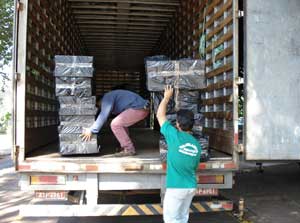
Aníbal López...Sculpture Smuggled from Paraguay to Brazil...2007...Sculpture with smuggled boxes, Digital video and photos
GPB: No, not exactly. The thing with dialectics and Hegelian thought is that there is always a thesis and antithesis, whose synthesis results in a resolution. In our case it is not about resolution but observation. In Rosa’s story, a man lives and moves between two riverbanks and at any point can go away again. The third bank where he “lives” refers to a temporary, precarious space. The “third way” also relates to politics in that it is neither left nor right, but a space in between. There has been a lot of critical discussion on the “third space” as a space of constant negotiation.
ML: The structure of this Biennial has changed considerably from its last iteration. Whereas in earlier years the Biennial was designed around national representations, this year the entire structure, and the group of curators involved, has all been coordinated by the chief curator, i.e., you. Once you were selected for this position, what kind of role did you play in determining how the Biennial would function?
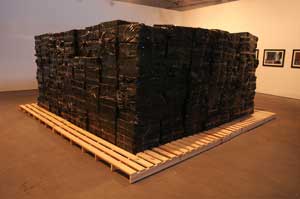
Aníbal López...Sculpture Smuggled from Paraguay to Brazil...2007...Sculpture with smuggled boxes, Digital video and photos
GPB: I was invited by the president of the Biennial Foundation to rethink the structure of the exhibition. But when we had our first meeting, I didn’t know I would be curating it. I didn’t have the typical biennial credentials. When we were having coffee, we talked about questions such as how to make it financially sustainable. I was interested in the management side of the operation. He responded by saying, “If we invite you, will you propose a structure?” So the solution was left up to me, and I was really given carte blanche to change the whole curatorial and management structure. I didn’t work by myself, of course — I had a team that similarly wanted to make changes.
ML: Education is clearly a major component in this Biennial — you have an education curator, Luis Camnitzer, as well as numerous conferences and workshops for the public. What kind of approach to education did you envision for this exhibition?
GPB: I wanted education to be at the center of this project. In this way I see the Biennial as a tool rather than a result. This isn’t a Biennial just for curators. Rather, we asked, “What kind of effect will this exhibition have on the thousands of people who will come to see it?” We plan on having 200,00 to 300,00 schoolchildren come through the show. When do you have a chance to work with an audience this big, most of whom are experiencing their first encounter with contemporary art? Many curators advocate for accessibility, but I often see these attempts as hollow. I knew if this Biennial was to survive, it couldn’t be just another sexy stop on the itinerary of curators and art dealers. Instead we imagined our key audience to be schoolchildren. We sat down with teachers and asked them, “How can we improve this?”
Teachers told us that they needed time to prepare in advance for children’s questions. So we started in March, the beginning of the school year in Brazil, and did exercises with them. Our teachers from the Biennial went to 35 cities and started talking about the artists’ ideas. The model was not about drawing art or learning the importance of a specific artist. Rather, it was a conceptual approach where we considered what the issues are. Then the kids would see the show six months later. Their visiting the Biennial, though, was not the beginning or end of the learning process: The Biennial was actually happening in classrooms six months in advance of its opening.
Education also affected the design of the space. We wanted areas for people to sit down, rest and write comments. You can go online and speak to curators and artists. We wanted the structure of the Biennial to be transparent, in the sense that people know what we are doing and why we are doing it. And I was pleased with the response. We always think audiences are stupider than they are. So many people come back with really refined answers.
ML: Can you think of any particular instances?
GPB: Sure. For example, one space features the work of Beth Campbell, an artist based in New York. She has created a bathroom wall repeated into space; each wall is slightly different. It’s a kind of philosophical joke. Another piece, called The American War, by Harrell Fletcher features all kinds of mutilated bodies from the Vietnam War. No curator would ever dare connect these two works, but one visitor did make the connection. He said he was thinking about repetition and the fact that wars are always repeated. In another example, Laura Belém makes tropical plants with leaves of brown paper. It’s a comment on the desire in the tropics to be European, to have a climate that they don’t have at home. One person’s response was to say, “A very small act can talk about a big problem.” Results like that.
ML: Speaking of the artists, how did you go about coordinating such a large group? In all, there are 67 artists in the show from 23 countries — how did you go about attacking that?
GPB: There’s a risk in every biennial that it can become like a theme park. My solution was to do as little as possible myself! The first thing I did was to cut the number of artists in half. The previous edition had about 180 artists. I wanted more time to work with individuals. I devolved the structure as much as I could and created a horizontal model.
In the “Conversations” component, a co-curator, Alejandro Cesarco, and I chose nine artists, then those nine artists each chose other artists. They came back with all kinds of things: feature films, composers, and people we had never heard of.
In the “Free Zone” component, we had four curators (including myself), and each could choose up to six artists. I did not intervene with the others. The idea was to choose the ones that you never forget, the ones you think about at night. Each curator interpreted this challenge differently. Luis Enrique Perez Oramas came up with an essay on Venezuelan art that he had been wanting to do. Others brought, again, artists I had never heard of. For the residency project “Three Frontiers,” I chose the artists [Aníbal López, Daniel Bozhkov, Minerva Cuevas and Jaime Gili].
In the end I only chose about 15 artists for the entire Biennial, which I’m very pleased about. I didn’t want to simply feature artists I always work with. Sometimes you see situations where everyone picks their own “football team.” At times others selected artists that weren’t my favorites, but it didn’t matter.
ML: Regarding the residency program in the Mercosul “Triple Frontier Zone” of Paraguay, Argentina and Brazil, surely the education process went both ways, in the sense that it was a learning process for the artists as well. What do you think they took away from the experience?
GPB: We had never done anything like a residency, so it was very experimental. There was no art school to host us, and we had some extreme situations. We went to see an indigenous performance in Paraguay and discovered that there are some things that art can’t talk about. We found that we were up against the limits of what we could do without acting like anthropologists. It’s usually very easy in a biennial to have a shared, accepted definition of art. But it is rare to throw yourself against the complete limit of a situation. One artist, Aníbal López, explores bringing in objects illegally — the issue of contraband. It’s important to take risks.
ML: Despite the geographical specificity of some of these projects, your insistence on not having a theme for this exhibition could be interpreted as a way of situating the Mercosul Biennial beyond a Latin American context. Do you want this Biennial to be perceived as “Latin American”? How has your position as a “Latin American” curator evolved over time? Do you consider yourself one?
GPB: I’ve always resisted that definition, and as for Latin America, I say that there is no such place. I don’t believe there is a thing called “Latin American art.” There are artists from the region, but the term is as useful as it is damaging. This is the first major project I’ve done in Latin America. I have always done it from the outside, from England or from the US. The Biennial draws from the southern cone — Argentina, Uruguay, Brazil, Chile — and it draws attention to that. I didn’t want this to be another global biennial, but it also couldn’t limit itself to only those countries, ignoring all else. So we go for something in between, something that starts in the local and goes to the global, not viewing the two in opposition. In “Conversations” you start with an artist from South America, but you can go anywhere from there. It’s all about where the artist is, and the artist is always both local and global. They make negotiations all the time.
ML: Having had this experience in Porto Alegre, how do you think it will affect your future curating? Surely this must have been a tremendous learning experience for you!
GPB: Yes, there was definitely a learning curve. I don’t know that I want to do such a large project again, but one thing I took away from it is that art can be such a social affair. In the art world of the US, we have a small audience, and we believe we have to infantilize art. But for this Biennial in a third-world country, we had 800,000 people coming in from a city the size of Austin. That’s most of the population! Also we in US museums have our priorities crossed in having education departments separated from curatorial departments. Really, curating is about strategies of communicating with the public.
The sixth Mercosul Biennial, Third Bank of the River, runs through November 18, 2007, in Porto Alegre, Brazil.
Images courtesy The Mercosul Biennial, Third Bank of the River
Miranda Lash is a writer and curatorial assistant at the Menil Collection



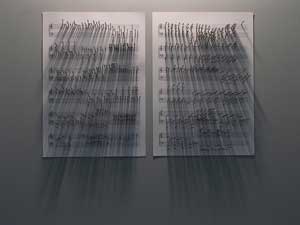
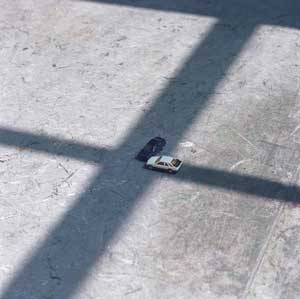
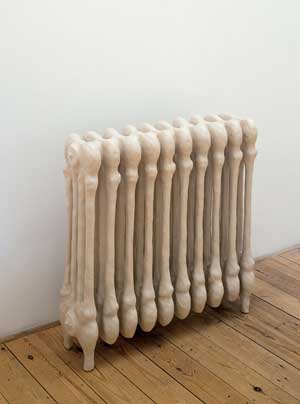
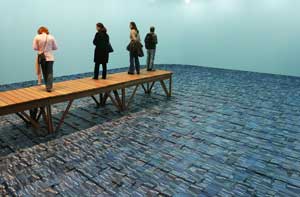
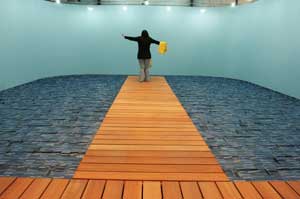

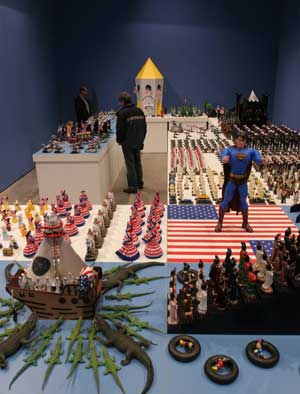
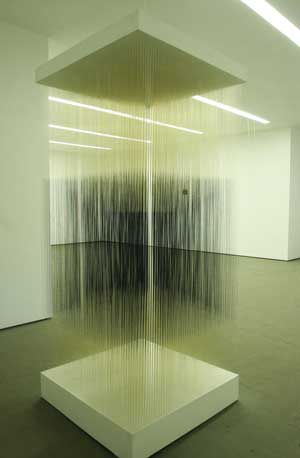



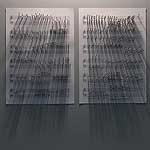

1 comment
If you are willing to buy a house, you would have to get the personal loans. Moreover, my brother usually utilizes a car loan, which supposes to be the most reliable.